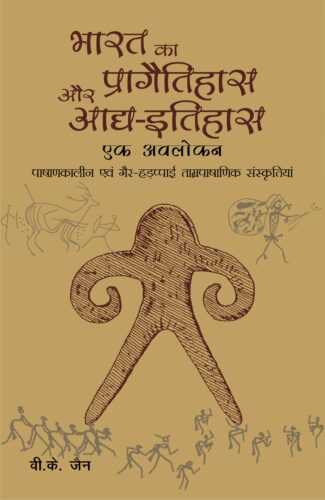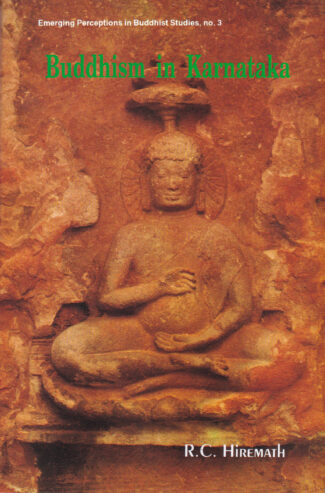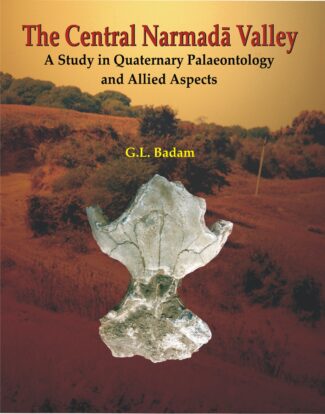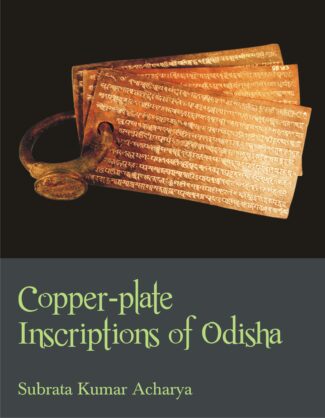Showing 21–30 of 184 results

Pursuing the path of yoga accomplishment, the practiser attains a few distinct supernatural powers. This book makes an attempt, through examples and extractions, to prove that these powers are not mere imginations but can be absorbed in the present materialistic world too.
Fresh excavations, new dating techniques and ever-growing conceptual frameworks since 1950 have greatly reshaped our perspective on Prehistory and Protohistory of the Indian subcontinent. This monograph, which is primarily aimed to serve as a starter for the undergraduate and postgraduate students, presents, in a concise but comprehensive manner, a syncretic view of the latest information on various aspects such as tools and technologies, settlement and subsistence patterns, ecological background and distributional configuration in respect of the Stone Age and the Chalcolithic Cultures outside the Harappan Zone. The Megalithic Cultures of peninsular India and the Deccan too find a place in the book. A glossary of the terms used frequently in archaeology as well as maps, line-drawings and explanatory notes on individual sites add further value to the text.

The bibliography includes 4081 entries, covering published materials in English and French languages over the last two centuries. The book gives a representative overview of what has been researched and accomplished in the field of Indian Buddhist Art and Archaeology since Wilkinss article on Bodh-Gaya in 1788 or Thomas Daniel’s first illustration on the Kanheri caves in 1798.
The bibliography includes 4081 entries, covering published materials in English and French languages over the last two centuries. It is divided into two parts. The first part contains 2410 entries dealing with Indian Buddhist art and archaeology and Indian art in general, history, religion, some Buddhist sites outside present India with special attention given to Pakistan , etc. Entries in the second part are exclusively devoted to Indian Buddhist sites. There are 57 sites; each one is individually studied. The book gives a representative overview of what has been researched and accomplished in the field of Indian Buddhist Art and Archaeology since Wilkins’s article on Bodh-Gaya in 1788 or Thomas Daniel’s first illustration on the Kanheri caves in 1798.

The book describes the organisation of the Buddhist centres in Karnataka, assesses the standing of Buddhism as a living, important religion prevalent there and accounts for its decay and departure to other countries.
Dr. R.C. Hiremath examines the age-old story of Siddhartha Gautamas early life and renunciation, providing the reader with the background of the Shramana schools that did not accept the authority of the Vedas. He treats, with meticulous scholarship, the Hinayana and Mahayana forms of Buddhism, and establishes that, contrary to popular belief, these two forms were not antagonistic to each other. The author maintains that Buddhism had in fact entered Karnataka before the time of the Emperor Ashoka, and that it enjoyed its heyday between the third century BC. and the third century AD. He describes the organisation of the centres, assesses the standing of Buddhism as a living important religion of Karnataka, and accounts for its decay and departure to countries outside the land of its birth. He discusses the impact of the religion on the literature of Karnataka, of which little, that is authentic, is yet known. Based on the Ashokan edicts found in the region, which are claimed to have been the first writings in Karnataka, Dr. Hiremath goes further to infer that the Kannada script and literature have been derived from Buddhistic literature and philosophy. Supported with reports of archaeological excavations and foreign travellers, the study gives a fresh insight on an hitherto untapped area. With highly informative appendix giving Devanagari text, Roman transliteration and translation of the inscriptions found in Karnataka, extensive bibliographic references, and a glossary of non-English words/phrases, the book holds out an enduring appeal to both scholars and discerning readers.
This book develops a consilience of research and thinking in epigraphy, archaeology, and linguistics on the Indic Brahmi writing system. Its objective is to identify the problems that need to be tackled by anybody who tries to develop a theory of the Brahmi writing system. As for the currently scientifically supported hypothesis that Brahmi originated in Tamil Nadu during the sixth century BCE or earlier, Patel opts for the need to keep this as an idea for the working basket awaiting new archaeological research in the sixth-century Magadha region.
The book deliberates upon how ancient Tamil Nadu was receptive to literacy. The Brahmanical fascination for orality blocked literacy in Vedic India. The brahmanas from north India entered Tamil Nadu only during the third century bce and lived away from residential areas. Tamil Nadu at the time had no caste system. This is reflected in the Sangam literature, which followed historically the grammarian Tolkappiyar. The conditions in Sri Lanka before and after the arrival of Buddhism are noted in relation to the rise of literacy. The relationship between Brahmi in Sri Lanka and Tamil Nadu is highlighted for the purpose of further research. Also noted is the need for research on the differences between Dravidian and northern scripts in the way the aksharas are formed in graphic representation.
प्रस्तुत पुस्तक बुन्देलखण्ड का इतिहास में बुन्देलखण्ड के सीमांकन, नामकरण एवं बुन्देला साम्राज्यों की स्थापना को रोचक ढंग से समझाने का प्रयास किया गया है।
अखिल भारतीय स्तर पर 1836 ई॰ में भारतीय स्वाधीनता का प्रथम प्रस्ताव चरखारी में पारित हुआ था। इसके बाद 1842 ई॰ के बुन्देला विद्रोह में जैतपुर नरेष पारीछत ने अपने सहयोगियों मधुकरशाह एवं हिरदेशाह के साथ मिलकर अंग्रेज़ों के दाँत खट्टे कर दिए। इसी प्रकार 1857 ई॰ की क्रान्ति में बानपुर राजा मर्दन सिंह, शाहगढ़ राजा बखतवली एवं रानी लक्ष्मीबाई ने अपने अन्य सहयोगियों के साथ मिलकर अंग्रेज़ों को अत्यधिक परेषान किया। बुन्देलखण्ड के अंग्रेज़ों ने सागर आकर जान बचाई। सागर के किले में पूरे 370 अंग्रेज़ों ने शरण ली। इस किले को चारों ओर से क्रान्तिकारियों ने घेर लिया। बड़ी मुश्किल से ब्रिगेेडियर जनरल ह्यूरोज ने बुन्देलखण्ड में 1857 ई॰ की क्रान्ति का दमन किया।
उक्त समस्त घटनाक्रम को प्रथम बार इस पुस्तक में सहज सरल एवं सुबोध ढंग से पिरोया गया है तथा बुन्देलखण्ड के इतिहास को प्रथम बार रोचक शैली में धाराप्रवाह ढंग से प्रस्तुत करने का हरसम्भव प्रयास किया गया है।
आशा है यह पुस्तक छात्रों, शोधार्थियों सहित इतिहास में रुचि रखने वाले आम नागरिकों को भी रूचिकर लगेगी।
प्रस्तुत पुस्तक के द्वारा भारत के स्वतंत्रता संघर्ष में बुन्देलखण्ड की जनता के योगदान को सामने लाने का प्रयास किसा गया है। गांधीजी की बुन्देलखण्ड यात्रा एवं ओरछा के समीप सतार नदी के किनारे चन्द्रशेखर आजाद के हरिशंकर ब्रह्मचारी के नाम से कुटिया बनाकर रहने से समस्त बुन्देलखण्ड में तेजी से राष्ट्रवादी भावनाओं का प्रसार हुआ। 1923 के झण्डा सत्याग्रह एवं 1930 के जंगल सत्याग्रह में बुन्देलखण्ड के लोगों ने बढ़-चढ़कर भाग लिया। ब्रिटिश भक्त देशी रियासत के राजाओं ने जब जनता पर अत्याचार किया तो जनता ने प्रजामण्डल की स्थापना कर उनका विरोध किया। इसी विरोध के फलस्वरूप संक्रांति के मेले के दिन 14 जनवरी 1931 को छतरपुर जिले में जलियाॅवाला बाग की तरह ही चरण-पादुका हत्याकाण्ड घटित हुआ। पं. माखनलाल चतुर्वेदी ने कर्मवीर समाचार पत्र के माध्यम से 1920 में रतौना में खोले जाने वाले कसाई खाने का इतना प्रखर विरोध किया कि सरकार को घबराकर अपनी कसाईखाना खोलने की योजना त्यागनी पड़ी। यह एक ओर बुन्देलखण्ड की धरती पर अंग्रेजों की करारी शिकस्त थी, तो दूसरी ओर पं. माखनलाल चतुर्वेदी की पत्रकारिता की महत्वपूर्ण जीत थी।
सागर के भाई अब्दुलगनी, ज्वाला प्रसाद ज्योतिषी, केशवराव खाण्डेकर एवं मास्टर बलदेव प्रसाद, दमोह के भैयालाल चैधरी, अजयगढ़ पन्ना के चंदीदीन चैरहा, छतरपुर के पं. रामसहाय तिवारी, टीकमगढ़ के लालाराम वाजपेयी एवं झांसी के भगवानदास माहौर आदि ने बुन्देलखण्ड के स्वतंत्रता संघर्ष को गति, दिशा एवं अर्थ प्रदान किया। इन्हें पं. द्वारका प्रसाद मिश्र एवं पं. सुन्दरलाल तपस्वी का कुशल नेतृत्व एवं मार्गदर्शन मिला। गोवा मुक्ति आन्दोलन में भी सागर की सहोद्राराय एवं केसरी चन्द मेहता सहित अनेक सत्याग्रहियों ने गोवा जाकर आन्दोलन को सफल बनाया। उक्त सभी घटनाक्रम की रोचक, सहज, सरल, सुबोध एवं तथ्यपरक जानकारी इस पुस्तक में दी गई है। छात्रों, शोधार्थियों, शिक्षक बन्धुओं सहित प्रत्येक वर्ग के लोगों को यह पुस्तक ज्ञानवर्धक एवं रुचिकर लगेगी।

The book is the first attempt at studying a small stretch of the Narmada Valley from a multidisciplinary point of view incorporating the results of archaeology, geology, palaeontology and taphonomy. The modern analogies attempt to build up a palaeoecological model for Narmada and its surrounding areas including the rock shelter sites.
The book The Central Narmada Valley: A Study in Quaternary Palaeontology and Allied Aspects is the first attempt at studying a small stretch of the valley from a multidisciplinary point of view incorporating the results of archaeology, geology, palaeontology and taphonomy. New techniques and parameters have been applied to study and re-interpret these areas. This book also summarizes the morphology, distribution pattern and evolutionary history of certain extinct animals in relation to cultural development. With the help of modern analogies, the book attempts to build up a palaeoecological model for Narmada and its surrounding areas including some of the rock shelter sites. The book extends the dimensions of understanding the life history of Narmada and its tributaries, not only by discovering and reinterpreting various biological and cultural events, but also by seeking to understand varied aspects like river behaviour, flood history and man-land relationship during the past. The book should prove useful to students and researchers of river valley cultures in general and to those of Narmada Valley in particular.

Based on diverse original sources, this is a well-knit narrative delineating Chandragupta Mauryas personality, his times, and his meteoric rise to political supremacy with contextual focus on polity, religion, society, economy, literature and arts.
A Ksatriya hero of little-known antecedents, Chandragupta Maurya was unmistakably a born leader of men, who within twentyfour years of his reign: 317 bc-293 bc, established a gigantic empire by not only unifying the countless fragments of a distracted India, but annexing some of the erstwhile Persian dominions as well. Professor Bhargava here profiles this first historical emperor of India, in all essential detail. Based on diverse original sources, notably, Brahmanical, Buddhist, Jaina, and Greek, the book sets out a fascinating, well-knit narrative delineating Chandragupta Maurya: the man, his times, and his meteoric rise to political supremacy with contextual focus on the state of polity, administrative mechanisms, religion, society, economy, literature and arts during his rule. The author also tries to apply correctives to the myths woven around Chandragupta in legend, literature, and chronicles. Acclaimed alike by historians and Indological journals of repute, Dr. Bhargavas book is now in its second edition: enlarged and thoroughly revised against the backdrop of the latest research findings.

This catalogue of more than 400 copper-plate inscriptions of Odisha from the fourth to the sixteenth century ce furnishes the detailed information about the rulers and the beneficiaries, religious persuasion of the kings, occasion and purpose of the land grants, eras and other astronomical details, numerical systems, development of language and script, administrative and revenue terms, etc.
Odisha is well known for its epigraphical wealth. More than 400 copper-plate grants and 1,000 stone inscriptions ranging from the fourth to the sixteenth century ce have been discovered so far. In this volume, the author has taken extreme care in documenting all the published and unpublished copper-plate grants including the stray plates, spurious charters and the palimpsests.
These epigraphs are grouped under different dynasties and the relevant data in each copper-plate inscription have been systematically classified making the volume a descriptive catalogue of the copper-plate inscriptions of Odisha. It, thus, painstakingly furnishes detailed information about the rulers and the beneficiaries, religious persuasion of kings, occasion and purpose of the grants, eras and other astronomical details, officers and persons present at the time of the grants, rights and privileges transferred to the donees, land measures, prevailing currency system of the period, administrative and revenue terms, topographical details, development of language and scripts, and so on. These inscriptions, mostly in Sanskrit, also delineate the system of numeration while specifying the era or days of a month, amount of tax to be paid, land measures, etc.
While adopting a comprehensive approach in treating the subject, the book deals with the technique of preparing copper plates for writing the royal deeds; flattening of the metal sheets into rectangular plates, their sizes, positing of the seals, the symbols and legends on the seals, amidst many more pieces of information.
This innovative and scholarly work should entice the spirit of students, historians and researchers, especially those who are interested in the history and culture of Odisha. The bibliographical details furnished in the volume will prove to be of immense help to serious scholars working in the field.